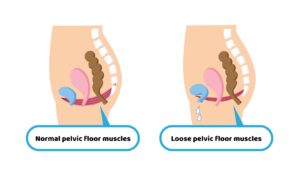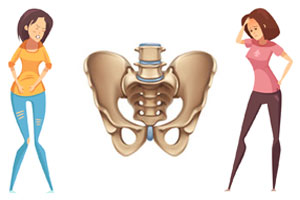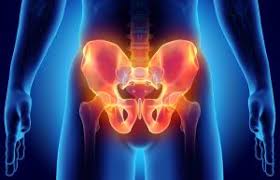If you are experiencing pelvic floor pain, you are not alone. This type of pain is very common and can be caused by a variety of factors. In this blog post, we will discuss the causes, symptoms, and treatments for pelvic floor pain. We will also provide some helpful tips on how to manage the pain. So if you are suffering from this condition, read on for information that can help you get relief!
Contents
What Is Pelvic Floor Pain?
 A pelvic floor is a group of muscles and ligaments that support the bladder, uterus, and rectum. These muscles and ligaments form a basin-like structure at the bottom of the pelvis. The pelvic floor muscles help to control urination and defecation. It is not uncommon for these muscles to become weak or damaged, which can lead to pelvic floor pain.
A pelvic floor is a group of muscles and ligaments that support the bladder, uterus, and rectum. These muscles and ligaments form a basin-like structure at the bottom of the pelvis. The pelvic floor muscles help to control urination and defecation. It is not uncommon for these muscles to become weak or damaged, which can lead to pelvic floor pain.
Many people believe that pelvic floor pain is caused by a variety of factors. It is a condition that can be caused by pregnancy, childbirth, menopause, and other factors. However, the most common cause of pelvic floor pain is weak or damaged muscles.
Pelvic floor pain can range from mild to severe. It can be a sharp pain or a dull ache. Pelvic floor pain may also be accompanied by other symptoms as well. If you are experiencing any of the symptoms, it is important to see your doctor.
How Does It Feel Like?
Pelvic floor pain is not an easy pain to define because it can feel like a multitude of things. It can be a deep achy pain, sharp shooting pain, or even a burning sensation. The pain can radiate to your lower back, buttocks, or thighs. It may only hurt when you sit down, stand up, cough, or sneeze.
Moreover, there are different types of pelvic floor pain. Some women experience what is called “vulvodynia.” This is a burning, stinging, or itching sensation around the opening of the vagina. There may also be pain during intimacy. Another type of pelvic floor pain is called “vestibulodynia.” This is when there is a burning, stinging, or itching sensation around the vaginal opening and/or pain during intimacy.
In addition, the most common symptoms are:
- Pain with intercourse
- Pain with tampon use
- Urinary frequency or urgency
- Constipation
- Difficulty emptying your bowels
- Low back pain
- Hip pain
- Groin pain
If you have any of these symptoms, it is important to see your doctor to rule out other possible causes. Because pelvic floor pain can be caused by a variety of things, it is important to get a proper diagnosis.
What Causes Pelvic Floor Pain?
 Pelvic floor pain has many possible causes. Some of the common ones:
Pelvic floor pain has many possible causes. Some of the common ones:
Childbirth
This is the most common cause of pelvic floor pain. The pressure of the baby passing through the birth canal can damage the muscles and nerves in the pelvic floor. This damage can lead to pain, incontinence (leakage of urine or stool), and sexual dysfunction.
Hormonal changes
It is also possible for pelvic floor pain to be caused by hormonal changes in the body. Hormonal changes can interact with the muscles, nerves, and other tissues in the pelvis, leading to pain. For instance, endometriosis is a condition in which the tissue that normally lines the uterus grows outside of the uterus. This can cause pain during ovulation and menstruation.
Obesity
This might seem like an obvious cause, but it’s worth mentioning because it’s a major risk factor for several different types of pelvic pain. Excess weight puts additional pressure on the pelvis, which can lead to pain in the lower back and hips, as well as in the pelvic floor muscles themselves.
Sedentary lifestyle
Lifestyle is always an important factor in anyone’s health. A sedentary lifestyle can contribute to many different health concerns and one of those is pelvic floor pain. It affects both men and women but is more common in women.
Heavy lifting
Sometimes, pelvic floor pain is caused by an injury or strain. This can happen if you lift something heavy, or if you suddenly twist your body the wrong way. If this happens, you may feel a sharp pain in your lower abdomen or pelvis. For example, if you were to pick up a heavy item from the floor and lift it without properly bending your knees first, you could put a strain on your pelvic floor.
Chronic constipation or diarrhea
It is estimated that up to 25 percent of people with pelvic pain have chronic constipation or diarrhea. These conditions can cause inflammation and irritation of the pelvic floor muscles and nerves. In addition, people who have chronic constipation may strain during bowel movements, which can also lead to pelvic floor dysfunction.
Pelvic surgery
 Finally, if you have undergone pelvic surgery, you may develop pelvic floor pain as a result. This is especially true if the surgery was extensive or if there were complications during the procedure. In some cases, the pain may be due to scar tissue that has developed around the surgical site. If you experience pelvic floor pain after surgery, it is important to talk to your doctor so that he or she can determine the cause and recommend the appropriate treatment.
Finally, if you have undergone pelvic surgery, you may develop pelvic floor pain as a result. This is especially true if the surgery was extensive or if there were complications during the procedure. In some cases, the pain may be due to scar tissue that has developed around the surgical site. If you experience pelvic floor pain after surgery, it is important to talk to your doctor so that he or she can determine the cause and recommend the appropriate treatment.
There are many potential causes of pelvic floor pain, and it is important to consult with your doctor to determine the underlying cause of your pain. Once the cause has been identified, there are a variety of effective treatments available to help relieve your pain and improve your quality of life!
How Is It Diagnosed?
A diagnosis is never an easy task, but when it comes to pelvic floor pain, your doctor will likely ask about your medical history and perform a physical exam. They might also recommend one or more of the following tests:
- Imaging tests: An X-ray, MRI, or CT scan can help identify any structural problems in the pelvis.
- Anal sphincter electromyography (EMG): This test measures the electrical activity of the muscles in the anal sphincter.
- Pelvic floor muscle strength testing: Weakening of the pelvic floor muscles can contribute to incontinence and other problems. This test assesses the strength of those muscles.
- Urinary stress tests: These tests evaluate for incontinence.
- Rectal exams: A gloved, lubricated finger is inserted into the rectum to check for abnormalities.
- Pelvic floor ultrasound: This test uses sound waves to create images of the pelvic floor muscles and tissues.
These are just a few tests that are commonly used to diagnose pelvic floor pain. Your doctor will likely tailor the testing based on your individual symptoms and health history. An accurate diagnosis is important in order to develop an effective treatment plan.
Therefore, if you are experiencing any pelvic pain, be sure to discuss your symptoms with your doctor. They will work with you to determine the cause of your pain and develop a treatment plan that’s right for you.
What Are the Treatment Options?
Once a diagnosis is made, your doctor will work with you to develop a treatment plan. This might include one or more of the following:
Medications
Over-the-counter or prescription pain relievers can help relieve this pain. Your doctor might also recommend a local anesthetic or antispasmodic medication. For example, there are some medicines that people might use for other conditions, like irritable bowel syndrome or bladder pain, that can also help relieve pelvic floor pain.
Injections
If medications don’t provide relief, your doctor might recommend injecting a local anesthetic into the pelvic floor muscles. This can provide temporary pain relief. Injections usually work best if you also receive physical therapy to learn how to relax the muscles. Botox injections are another type of injection that can be used to treat pelvic floor pain.
Physical therapy
 A physical therapist can teach you exercises to help stretch and strengthen the pelvic floor muscles. This can help reduce pain and improve bowel and bladder control. For example, if you have pain during intimacy, the therapist can teach you how to relax the muscles before and during the intimacy. The common physical therapies might include:
A physical therapist can teach you exercises to help stretch and strengthen the pelvic floor muscles. This can help reduce pain and improve bowel and bladder control. For example, if you have pain during intimacy, the therapist can teach you how to relax the muscles before and during the intimacy. The common physical therapies might include:
- Exercises: The therapist will teach you how to do exercises at home to stretch and strengthen the pelvic floor muscles.
- Biofeedback: This is a technique that uses a monitor to help you see and control your pelvic floor muscle contractions. This can help improve your ability to control the muscles.
- Electrical stimulation: This is a treatment that uses electrical currents to stimulate the pelvic floor muscles and may help reduce pain.
- Manual therapy: The therapist may use their hands to massage and stretch the muscles in the pelvic area.
Surgery
In some cases, surgery might be needed to release tight pelvic floor muscles or to remove scar tissue. For example, surgery for pelvic floor pain might be done to:
- Release trigger points in the pelvic floor muscles
- Release entrapped nerves
- Treat endometriosis
- Remove scar tissue
- Relieve pressure on the pelvic floor muscles from an overactive bladder or rectum
After surgery, you might need to do pelvic floor muscle exercises and have physical therapy to help you recover. For example, you might need to:
- Learn how to correctly do pelvic floor muscle exercises
- Strengthen your pelvic floor muscles
- Improve your range of motion
Lifestyle changes
Certain lifestyle changes might also help reduce pelvic floor pain. These might include:
- Losing weight
- Quitting smoking
- Avoiding constipation
- Limiting or avoiding caffeine and alcohol
- Wearing loose-fitting clothes
- Avoiding high heels
- Practicing good posture
So these are some changes that you should make in order to reduce this type of pain. However, if the pain persists, it is best to consult with a doctor. More often than not, the pain is a result of some sort of injury or condition that requires medical attention.
Overall, these are some tips that can help you reduce pelvic floor pain. Be sure to talk with a doctor if the pain persists, as it might be indicative of a larger problem.
Conclusion
In a nutshell, pelvic floor pain is a chronic pain condition that can cause a great deal of discomfort and make it difficult to carry out everyday activities. There are many different potential causes of this type of pain, and it can often be a symptom of another underlying condition. Treatment options vary depending on the cause of the pain. But one thing is for sure treatment can help you to recover!
Therefore, do not hesitate to consult a doctor if you are experiencing any type of pelvic pain. With the right diagnosis and treatment, you can get your life back on track!
Physical Therapy help patients recover from pain. If you’re experiencing Back pain, Shoulder pain, Knee pain, Neck pain, Elbow pain, Hip pain, or Arthritis pain, a physical therapist at MantraCare can help: Book a physiotherapy session.


